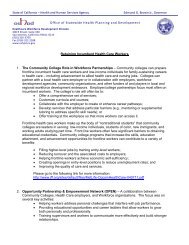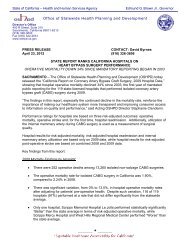Best Practices for Project Management, Design, and Construction of ...
Best Practices for Project Management, Design, and Construction of ...
Best Practices for Project Management, Design, and Construction of ...
You also want an ePaper? Increase the reach of your titles
YUMPU automatically turns print PDFs into web optimized ePapers that Google loves.
the design assistance from the manufacturer to design the room to support the physical<br />
requirements (electrical, mechanical, plumbing, space needs, etc.) <strong>of</strong> the equipment.<br />
Clinical equipment manufacturers’ work with the project designers to provide a floor plan<br />
<strong>for</strong> approval by the owner, this floor plan is the basis <strong>of</strong> design <strong>for</strong> the equipment<br />
installation <strong>and</strong> operation.<br />
Typically large hospital projects are designed in increments. Increment 1 would be<br />
foundation <strong>and</strong> steel, Increment 2 would be the build out <strong>of</strong> the floors, Increment 3 clinical<br />
equipment, etc. Increment 1 <strong>and</strong> Increment 2 plans would include designed shelled space<br />
<strong>for</strong> the clinical equipment. This space should be labeled on the plans <strong>for</strong> the intended<br />
future use. Increment submittals should be submitted up front. This will assist OSHPD<br />
plan reviewers <strong>and</strong> improve plan review turnaround time.<br />
Determining the schedule <strong>for</strong> the selection <strong>and</strong> delivery/installation <strong>of</strong> the equipment is a<br />
collaborative ef<strong>for</strong>t by the owner <strong>and</strong> the design team. One effective method is to use the<br />
project schedule to determine the date <strong>of</strong> beneficial occupancy <strong>and</strong> then work back. The<br />
manufacturer has an installation <strong>and</strong> testing schedule requirements, the design team can<br />
provide the schedule requirements <strong>for</strong> design, OSHPD <strong>and</strong> construction. With this<br />
in<strong>for</strong>mation, a procurement schedule can be developed.<br />
<strong>Design</strong>ers should design the “shell space” large enough to accommodate any<br />
manufacturers’ clinical equipment <strong>of</strong> the type needed. The mechanical, electrical <strong>and</strong><br />
plumbing (MEP) systems should be sized accordingly to meet equipment needs. Some<br />
owners require the designers to increase MEP system’s capacity by 10% to 20% to<br />
ensure future changes to technology can be accommodated.<br />
Deferred Submittals -Low Voltage (In<strong>for</strong>mation Technologies/In<strong>for</strong>mation Services)<br />
<strong>Design</strong><br />
As with the Clinical Equipment issues addressed in <strong>Best</strong> <strong>Practices</strong> 13A Clinical<br />
Equipment, low voltage design requires special attention. These systems are complex,<br />
unique <strong>and</strong> rapidly changing <strong>and</strong> require a designer with the necessary specialized<br />
knowledge <strong>and</strong> experience. The owner should require that the architectural <strong>and</strong><br />
engineering team include a low voltage design engineer. Or the owner can assign a low<br />
voltage design pr<strong>of</strong>essional that knows the facility <strong>and</strong> can make decisions <strong>for</strong> the owner.<br />
The design team should work in collaboration with the hospital’s In<strong>for</strong>mation Technology /<br />
In<strong>for</strong>mation Services (IT/IS) staff to develop the basis <strong>of</strong> design (systems, capacities,<br />
technology, HVAC requirements, future growth, etc.) <strong>and</strong> to review the construction<br />
drawings as they progress. One <strong>of</strong> the first issues that should be resolved is the project’s<br />
responsibilities verses IT/IS’s responsibilities. Many IT/IS departments have a select<br />
number <strong>of</strong> low voltage contractors that they have confidence in <strong>and</strong> with which they work<br />
on a regular basis. This may work satisfactory <strong>for</strong> small IT/IS projects but could be a<br />
significant issue <strong>for</strong> large project.<br />
(OSHPD <strong>Best</strong> <strong>Practices</strong>) Page 99 DRAFT FINAL, Sept. 2011
















